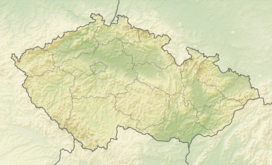Dyje-Svratka Vale
| Dyje–Svratka Valley | |
|---|---|

View from Výhon down to the Dyje–Svratka Valley
|
|
| Highest point | |
| Peak | Výhon |
| Elevation | 355 m n.m. |
| Dimensions | |
| Length | 83 km (52 mi) |
| Area | 1,452 km2 (561 sq mi) |
| Geography | |
| Country | Czech Republic |
| State | Moravia |
| Range coordinates | 49°00′N 16°18′E / 49°N 16.3°ECoordinates: 49°00′N 16°18′E / 49°N 16.3°E |
| Parent range | Carpathians |
| Geology | |
| Orogeny | Alpide belt, outer depression |
| Age of rock | Neogene |
| Type of rock | Gravel and Sand |
The Dyje–Svratka Valley (Czech: Dyjsko-svratecký úval, German: Thaya-Schwarza Talsenke, Slovak: Dyjsko-svratecký úval) is a geomorphological feature (specifically a special type of Vale) in Moravia (The Czech Republic). The highest prominence over the Dyje–Svratka Valley is Děvín Peak at 549 metres (1,801 ft).
The Dyje–Svratka Valley has been a natural pass between the Vienna Basin (Carpathians) and the Vyškov Gate, the Upper Morava Valley, Moravian Gate and later, the North European Plain (Poland - Lower Silesia - Galicia) since ancient times. It served as an arm of several important trade routes from southern Europe to the Baltic Sea such as the Amber Road, as well as routes from Moravia to Upper Silesia and Lesser Poland.
The Emperor Ferdinand Northern Railway from Břeclav to Brno traverses the Dyje–Svratka Valley.
Highways that traverse the Dyje-Svratka Valley include D1 from Prague to Brno, D2 from Brno to Břeclav and Bratislava, and D52 from Brno to Vienna).
...
Wikipedia

